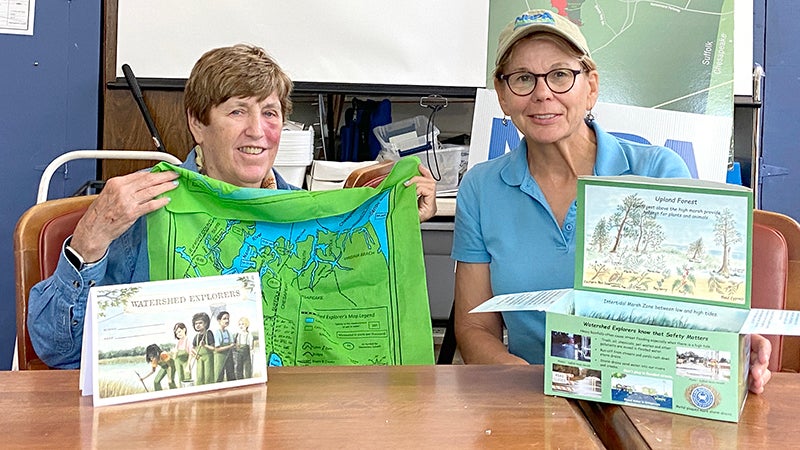NRPA creates watershed explorers
Published 7:24 pm Friday, August 6, 2021

- Karla Smith and Elizabeth Taraski show off the different items found in the Nansemond River Preservation Alliance’s learning kits.
|
Getting your Trinity Audio player ready...
|
The Nansemond River Preservation Alliance created a unique way to continue working with students when they could no longer physically go to the classrooms.
The NPRA started in 2009 to restore and protect the environment and local waterways in Suffolk. The alliance does adult education but found that educating in the schools was much more effective.
“We found that the biggest way to get people involved is to educate the kids,” said Karla Smith, chair of the environmental education committee for NRPA. “When involving kids, their parents have to take them to the outdoor events, and it brings enthusiasm into the home and gets their teacher involved. It really helps build momentum.”
In 2012, the alliance started working with students at Suffolk Public Schools to teach them what the NRPA does and why. They would take students to do water quality testing and even go on boat trips or to marshes for hands-on learning.
Smith, a retired teacher who worked with upper elementary students, realized that working with the lower grades might be better. So, they switch from seventh grade and high school to third grade.
With COVID-19 not allowing anyone in the classroom, the NRPA had to get creative in how to still be involved when visitors and most of the students couldn’t come back to the classroom.
“The pandemic gave people extra time, and we got to get creative and very productive during this period,” said Elizabeth Taraski, NRPA president. “This allowed us to do things we would never have otherwise.”
They decided to make kits that went along with the state’s Standards of Learning testing that the students could do on their own and keep. Each box contains critter stickers, a learning journal, a ruler and a map of Suffolk and its waterways printed on a fun, colorful bandanna.
The box is also decorated to be interactive with the assignments in the journal. Different parts of the inside are illustrated as the upland forest, intertidal marsh zone and the oyster reef at the bottom. One assignment has students place the critter stickers in the zones they would live. On the bottom of the box are 25 oyster shells of various sizes for students to measure with their ruler. The bandanna map is unique because not only does it have Suffolk and its waterways, but also each elementary school is marked to let students figure out the waterway closest to them.
“When you ask students who has been on the waterways, only 5% raise their hands,” said Taraski. “As you learn more about where you live, it goes into civic involvement. We introduce them to natural resources, and it’s eye-opening.”
The NRPA and its volunteers also created videos to go along with the learning journal. These take place right along the Nansemond River, showing the students onsite what they may have done or watched in person if not for the pandemic.
One of their major partners to make these kits is Dominion Energy, which has partnered with the NRPA since 2013 to help with their school outreach.
“Protecting and preserving the environment is part of our core mission at Dominion Energy,” said Bonita Billingsley Harris, Eastern Region policy director at Dominion Energy. “It is our honor to support the Nansemond River Preservation Alliance’s Watershed Explorers program as they work to educate the next generation of environmental stewards.”
According to Harris, in January, the Dominion Energy Charitable Foundation announced it awarded $1.3 million in grants to 118 organizations working to improve natural spaces or to teach about the environment. Over the last 15 years, Dominion Energy has donated over $37 million to a wide variety of environmental projects near communities served by Dominion Energy companies.
Another sponsor was the Hampton Roads Community Foundation, and the Junto Woman’s Club of Suffolk helped pack more than 500 boxes for the students.
The NRPA hopes to be able to go into the schools again during the 2021-22 school year to team teach in February, if the state of the pandemic allows.
“We’re really excited,” said Taraski. “I think the students who could do it this year had fun.”






